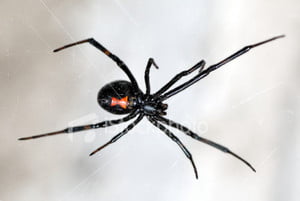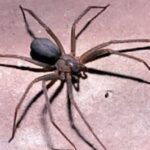Did you know there are 6 different types of Black Widow spider?
Yep, there sure are! Luckily only two types can be found in the Americas. Unluckily, one of those types were found in my front and back yards.
I’m no stranger to clutter. I have clutter in my home, I have clutter in my yard. Not cars on blocks type of clutter but I have things that likely belong in storage that ended up outside. Even though I thought I kept things neat, orderly and bug free I was WAY off base. My husband found the first Black Widow spider around the stairs leading from our back door. It was very small, likely not bigger (body wise) than an eraser on a pencil. It certainly had the red hourglass though. That red hourglass symbolizes that not only is this the most venomous spider in America but that it’s the female of the species.
The male Black Widow isn’t black at all but usually a brown color, as are the adolescent widow spiders. The one my husband found was likely an adolescent and had not yet laid an egg sack. I found another a couple of weeks later by our front stairs. The spider didn’t build her web in any sort of hiding spot but rather out in the open. It was only a tad larger than the other spider but still was certainly a Widow. Just the other day I found yet another of these spiders but it was under some vehicle ramp equipment we had outside of our home. This Black Widow was (body only) around the size of a dime. Her web was large and had no distinction other than a cobweb. There it was on the side of the web, her egg sack. Her body long and black with a shiny back and stomach, a red hourglass on her abdomen and a red dot on her bottom. My husband made short work of her and her unborn spiders, but what about others? I’m afraid to even let the kids play outside. Why is that? Because I grew up on a farm where my family always said “a bite from a Black Widow is as poisonous as a bite from a rattlesnake and it will kill you”. Is that true? Only partially.
All widows are venomous, that is true, but only 1% actually inject enough venom to be harmful to humans. Yes it can give you a nasty sting and possibly an infection but to kill you… not likely. This isn’t exactly true for infants, toddlers and the elderly. Their weaker immune systems can not fight the venom like a heathier average person’s can. As with a rattlesnake though, it DOES have venom and should NOT be messed with.
Did you know??
*Black Widows mate in the Spring
*they can have between 200 and 700 eggs in one egg sac
*the widow can give birth to 4-9 egg sacs per summer season
*a Black Widow can live for up to THREE YEARS!
*the female stores sperm so that she may produce more babies without mating again
*Just because they call her a black widow it’s not because she’s always a widow (though she is always black). Where most people thought the female Widow eats her mate after they have sex, they usually don’t. Not unless she’s especially hungry does she ever kill her mate.
*even though there can be 700 eggs in one sack only 1-12 or so actually survive due to cannibalism within the sac
Since we have killed three of them now I’m certain there are more. I just have to find them. If you are bitten by a Black Widow and you start feeling numb, see swelling or unusual redness, muscle cramps, irregular heartbeat or begin vomiting, please call Poison Control or get to your local Hospital or Physician immediately. The venom is neurotoxic, which means it travels in your nervous system.
How do you get rid of these spiders? Well, killing them for one. Keep wood piles and junky areas clean. Use gloves when moving anything outdoors. You can use labeled industrial sprays but they won’t always work, as the spiders just avoid where you’ve treated and move elsewhere rather than actually killing it. Though if you do spray it directly on the spider, it’s very likely it will kill it.



